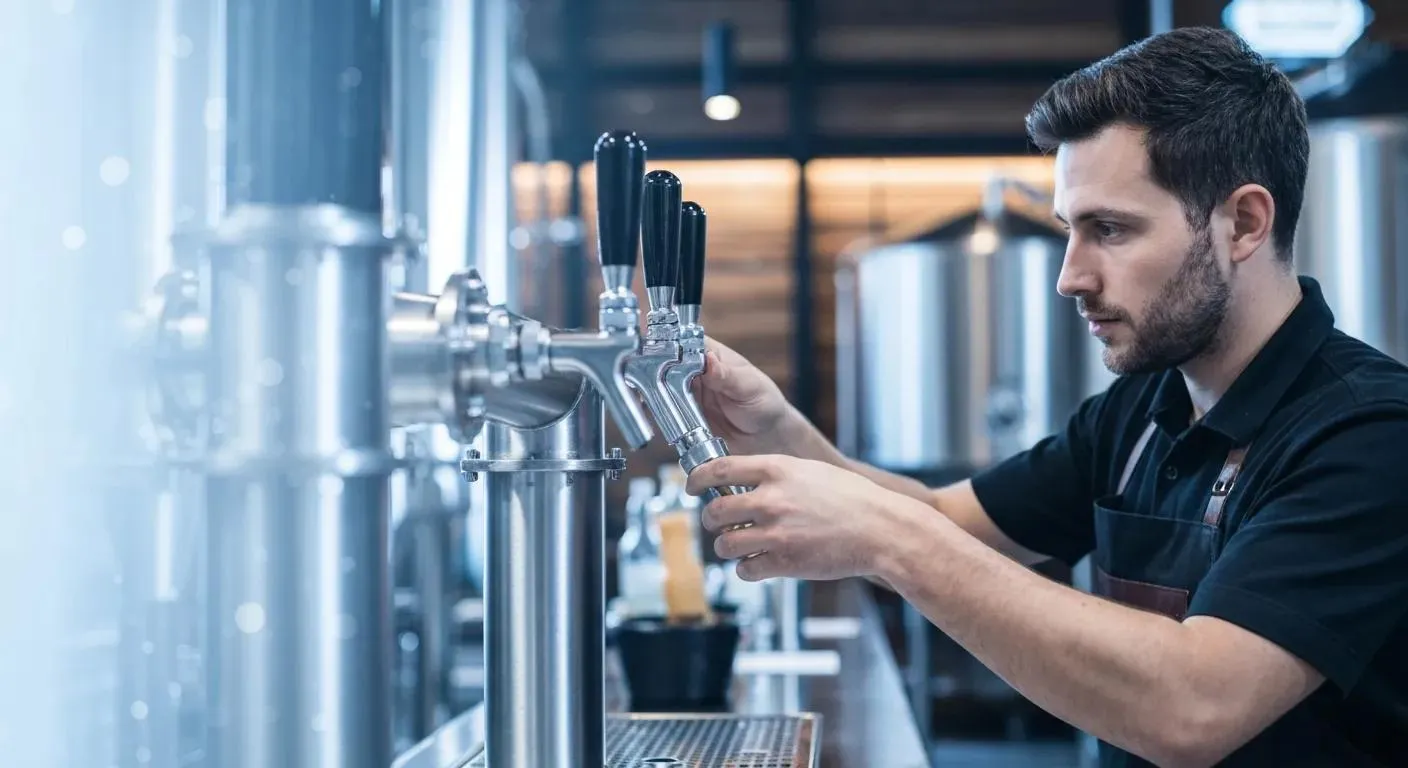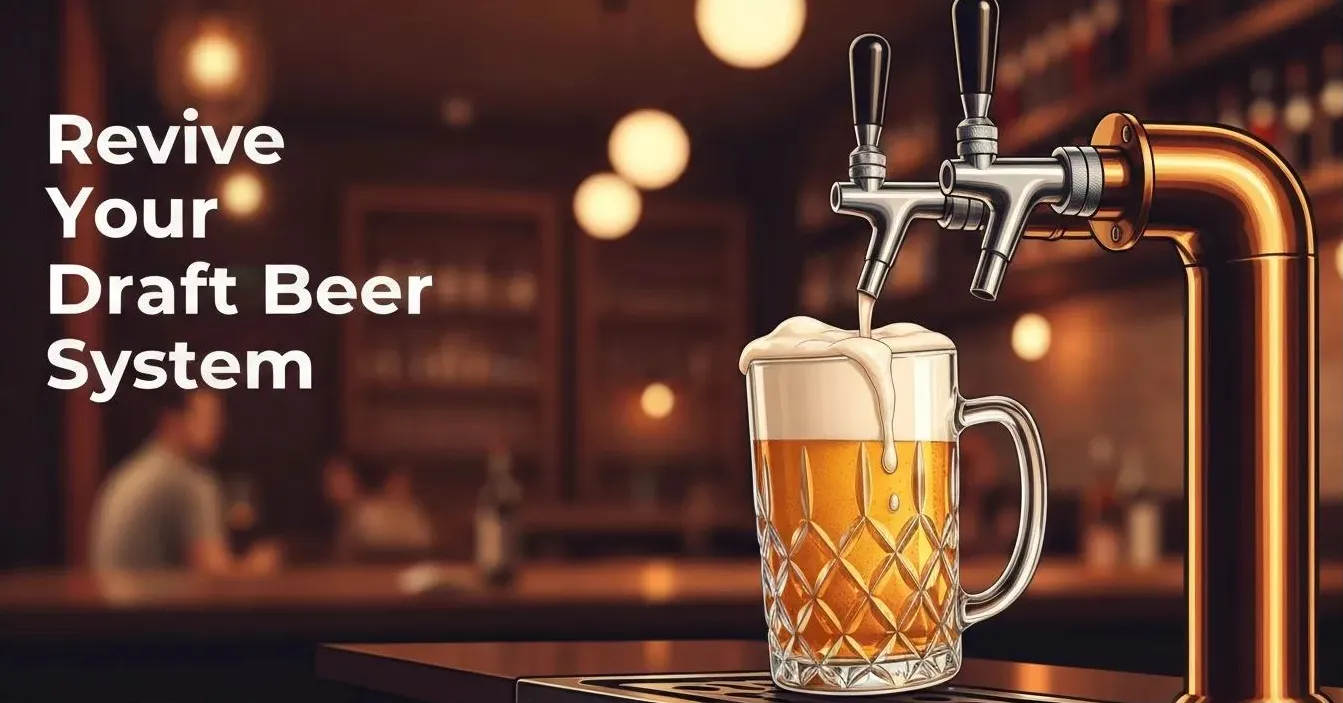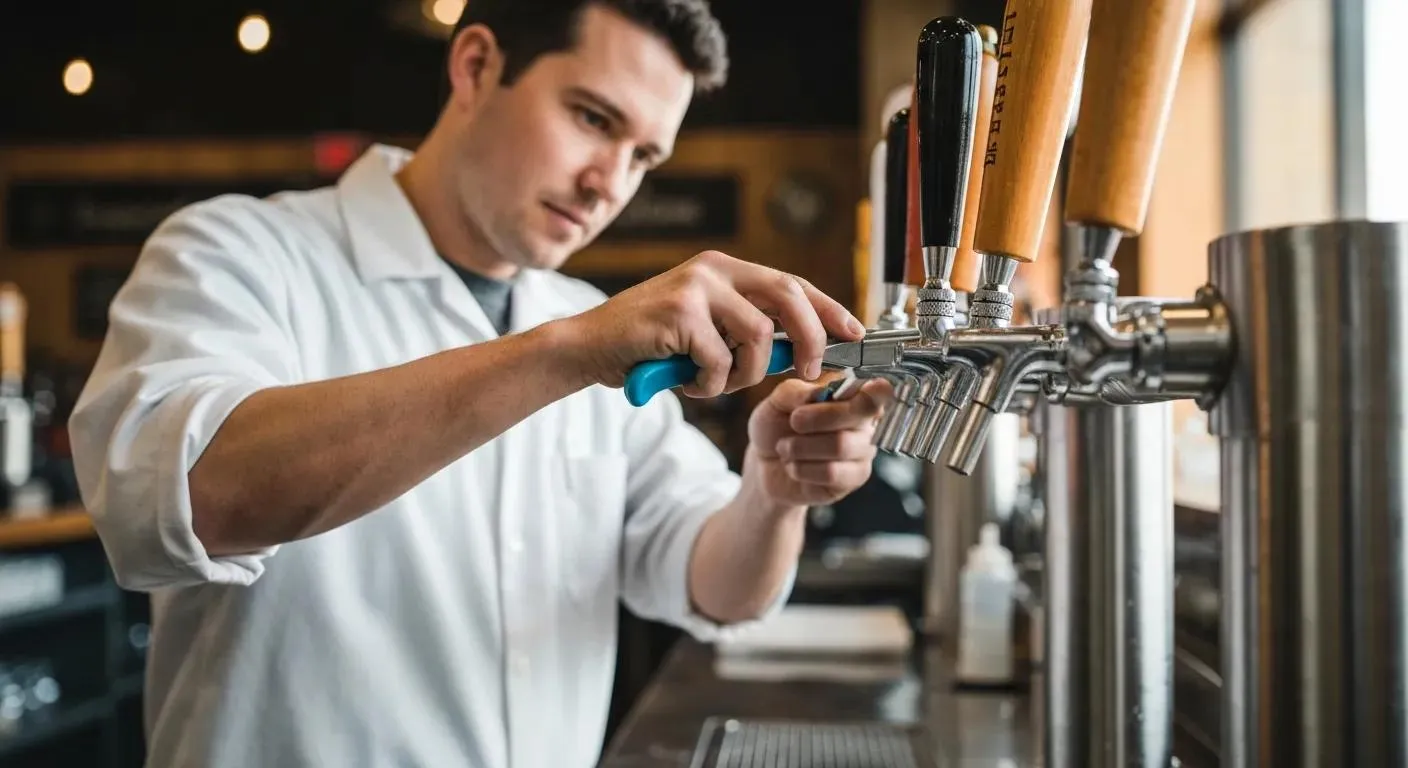Beer Line Cleaning Equipment Methods: Ensuring Pure Pours and Perfect Taste

The cleanliness of beer lines is crucial for maintaining the quality and taste of draft beer. Over time, lines can become contaminated with yeast, bacteria, and beer stone, which can result in off flavors and poor presentation of the beer served. To ensure that every pint is as fresh and flavorful as the brewer intended, a well-executed cleaning regimen using the right equipment and methods is essential. Understanding the various cleaning methods and equipment available will help proprietors of bars, pubs, and restaurants, as well as home enthusiasts, keep their draft systems sanitary and functioning optimally.
Selecting the appropriate cleaning equipment and supplies is the first step to effective beer line maintenance. This can range from simple manual cleaning kits to advanced electronic systems that provide thorough cleansing. Manual methods may involve the use of a cleaning pump to push a specialized solution through the lines, while more modern techniques can include automated systems that clean at preset intervals. Furthermore, each method has its own set of tools, from brushes to cleaning solutions, which are designed to tackle different aspects of beer line contamination. Planning a detailed cleaning schedule and following the steps diligently can prevent common issues such as excess foam, off-tasting beer, and potential health risks.
Key Takeaways
- Clean beer lines are vital for the quality and safety of draft beer.
- Proper equipment and a thorough process are necessary for effective cleaning.
- Regular maintenance ensures consistent performance and flavor integrity of draft systems.

Fundamentals of Beer Line Cleaning
Ensuring that beer lines are properly cleaned is critical for maintaining both beer quality and a sanitary environment. Regular and thorough cleaning processes remove the buildup of yeast, mold, and bacteria, which are detrimental to both the health and taste of draft beer.
Importance of Clean Beer Lines
Clean beer lines are crucial because they prevent the accumulation of yeast, mold, and bacteria which can lead to off-flavors and compromise beer quality. This is not just about taste; it's a matter of health and safety for consumers. The presence of these contaminants can spoil the beer and can be harmful if ingested. Maintaining a sanitary environment within the beer lines preserves the true flavor of the beer and ensures that customers are served a product that's safe and enjoyable.

Frequency of Cleaning
The frequency of cleaning beer lines should be dictated by the volume of beer served and the types of beer that flow through the lines. However, cleaning should typically occur at least once every two weeks. Higher temperatures and higher beer throughput may necessitate more frequent cleaning to prevent the rapid growth of undesirable microorganisms.
Beer Type Recommended Cleaning Frequency Standard Ales and Lagers Every 2 weeks Beers with High Sugar Content 1-2 times a week Beers at Warmer Temperatures Every week
Safety Considerations
When cleaning beer lines, one's safety must be an absolute priority. The use of personal protective equipment (PPE), such as gloves and eye protection, is important when handling chemical cleaning solutions. These solutions can be corrosive and pose a risk if mishandled. It is vital to follow the manufacturer's instructions on the proper use and disposal of cleaning agents to ensure the health and safety of both the employee conducting the cleaning and the end consumer.
Equipment and Tools for Beer Line Cleaning
Maintaining the quality of draft beer relies heavily on the cleanliness of the lines it flows through. The right tools and chemicals are essential for effective maintenance and ensure the draft system operates efficiently without compromising beer flavor.
Types of Cleaning Equipment
Beer line cleaning requires specific equipment to remove buildup and ensure sanitary conditions. The essential tools include a cleaning brush for manual scrubbing, beer line cleaning kits that offer a complete set of tools, and recirculation pumps that facilitate the cleaning solution to move through the lines. Cleaning kegs are also used as part of some systems, designed to work under pressure to push cleaners through the system.
- Beer Line Cleaning Kits: Packages typically contain a faucet wrench, chemicals, and a hand pump.
- Cleaning Brush: Manually removes residue within the lines.
- Hand Pump: Creates pressure to push cleaning solutions through the system.
- Recirculation Pump: Enables continuous flow of the cleaner for thorough sanitization.
- Cleaning Keg: Designed to hold the cleaning solution and connect to the system, replicating the beer keg operation.

Using the Right Chemicals
Choosing the correct cleaning solutions is critical. Alkaline-based cleaners are commonly used due to their effectiveness at breaking down organic materials. In contrast, acid-based cleaners can target beer stone and mineral deposits. Using an industry-standard cleaning solution ensures that the most common contaminants are effectively removed without damaging the beer lines.
- Alkaline-Based Cleaners: Effective for organic buildup.
- Acid-Based Cleaners: Used to remove mineral deposits.
- Both types should be used in accordance with the manufacturer's instructions for safety and efficacy.
Manual vs. Automated Systems
There are two main approaches to cleaning beer lines: manual and automated. Manual cleaning typically involves disassembling the tap, attaching the hand pump, and physically pumping the cleaning solution through the system. This method can be labor-intensive but cost-effective for smaller operations. Automated systems, on the other hand, use a static line cleaning unit or a recirculation pump to clean lines with minimal manual intervention. These systems provide consistent and thorough cleaning, beneficial for establishments with numerous taps.
- Manual Systems: Require hand pumps or using a Cleaning Canister.
- Automated Systems: Utilize a recirculation pump and offer thorough, consistent cleaning with less manual effort.

Cleaning Process Detailed Steps
The cleaning of beer lines is pivotal to maintaining quality and taste. Detailed steps ensure thorough and safe cleaning, removal of residues, and prevention of contamination.
Preparation and Safety
Before commencing the cleaning cycle, one should gather all required equipment, including cleaning solution, gloves, and PH strips. Safety is paramount, therefore wearing protective gloves is essential to avoid direct contact with potentially harmful cleaning chemicals.
Cleaning Cycle Execution
Cleaning a draft beer system using a recirculating pump is a detailed process that requires careful attention to ensure the system is properly sanitized and maintained. Here's a step-by-step guide that's simplified for easy understanding:
Steps to Clean a Draft Beer System
Step 1: Prepare the Cleaning Solution
- 1.1. Mix the cleaning solution according to the manufacturer's instructions in one of the buckets. Always wear gloves and goggles for safety.
Step 2: Disconnect Kegs
- 2.1. Turn off the CO2 gas supply.
- 2.2. Disconnect the kegs from the system.
Step 3: Set Up the Recirculating Pump
- 3.1. Place the intake hose of the recirculating pump into the bucket with the cleaning solution.
- 3.2. Connect the output hose of the pump to the beer line system where the keg was connected.
Step 4: Begin Recirculation
- 4.1. Turn on the pump and allow the cleaning solution to circulate through the system for at least 15-20 minutes.
- 4.2. Ensure that the solution flows through each beer line and faucet.
Step 5: Clean Faucets and Couplers
- 5.1. While the solution is circulating, dismantle the faucets.
- 5.2. Use brushes to clean the faucets and couplers thoroughly.
- 5.3. Rinse these parts with clean water and dry with a cloth.
Step 6: Flush the System
- 6.1. After circulating the cleaning solution, turn off the pump.
- 6.2. Flush the lines with clean water to remove any remaining cleaning solution. Flush the lines with water until the PH strips indicate neutrality, ensuring all chemicals are removed.
Step 7: Reassemble and Reconnect
- 7.1. Once the lines are thoroughly rinsed, reassemble the faucets.
- 7.2. Reconnect the kegs to the system.
- 7.3. Turn on the CO2 gas supply.
Step 8: Final Check and Clean-Up
- 8.1. Check for any leaks or issues in the system.
- 8.2. Clean up your workspace, ensuring all tools and materials are put away.
- 8.3. Properly dispose of or store the cleaning solution and rinse water.
- Be Thorough: Take your time to ensure every part of the system is cleaned properly.
- Regular Maintenance: Regular cleaning is crucial for maintaining the quality and taste of the draft beer.
Remember, cleaning a draft beer system is not just about keeping it looking good, but it's also about ensuring the beer served is fresh, tastes great, and is safe to drink.

Troubleshooting Common Issues
Maintaining clean beer lines is vital to the quality of beer served. Contaminants like mold and sediment can affect both taste and safety, while chemical imbalances may lead to off-flavors and odors. Properly addressing these issues ensures a consistently high-quality beer experience.
Handling Mold and Contaminants
Mold growth and other contaminants in beer lines are often due to infrequent cleaning or improper sanitization. To tackle mold, one should first flush the lines with a caustic cleaning solution to break down organic matter. After flushing, an acid-based cleaner can help prevent future growth by altering the pH to a level not conducive to mold. Renowned cleaning methods include using solutions like 2% to 3% Sodium or Potassium Hydroxide at 80°F to 100°F for proper eradication of biofilms and beer residue.
Dealing with Beer Stones
Beer stones, a type of calcium oxalate deposit, can affect the taste of your beer and lead to equipment issues. Regular cleaning cycles with specialized acid-based solutions are necessary to dissolve these stubborn deposits. It's recommended to follow up with a thorough rinse to ensure no acid solution remains in the lines that could potentially influence beer taste.

Addressing Off-Flavors and Odors
Off-tastes and odors can be indicative of contaminants or sediment that regular cleaning might miss. These flavor inconsistencies can be resolved by using a comprehensive cleaning regime that includes both alkaline and acid-based solutions to neutralize the contaminants. Ensuring all equipment is properly sanitized is also key to eliminating adverse tastes from molds or other microbial entities.
Maintenance and Regular Upkeep
Maintaining a draft beer system is critical for ensuring fresh taste and aroma, as well as for prolonging the lifespan of the equipment. Regular cleaning and maintenance reduce waste and service costs while preserving the quality of ales and lagers.
Draft System Cleaning Schedule
Frequency: Beer lines should be cleaned at least every two weeks to maintain a sanitary environment within the system. Increased cleaning frequency may be necessary depending on the usage volume and type of beer dispensed.
- Daily: Check for leaks or wear and promptly address any issues.
- Bi-Weekly: Conduct a thorough cleaning with a recommended beer line cleaner.
Ensuring Fresh Taste and Aroma
A kegerator or draft system that isn't clean can impart off-flavors to beer, thereby compromising its fresh taste. This can result from yeast, bacteria, or beer stone build-up. Proper clean beer lines are essential for preserving the intended flavor profile of ales and lagers.
- Immediate Action: Clean components after each keg change.
- Chemical Cleaners: Use appropriate cleaning solutions approved for food-grade contact.

Long-Term Equipment Care
Investing in regular maintenance avoids costly repairs and ensures consistent performance. System components such as taps, hoses, and couplers require attention to avoid the unnecessary cost and waste associated with improper care.
- Inspection: Perform routine checks on all components.
- Replacement: Replace worn or damaged parts to avoid service interruptions.
By adhering to these practices, stakeholders can ensure the draft beer system remains clean, efficient, and cost-effective while providing patrons with the highest quality beverage experience.
Frequently Asked Questions
In ensuring the quality and safety of draft beer systems, having clear and concise answers to frequently asked questions can be invaluable for both novice and experienced individuals involved in the regular maintenance of beer lines.
What is The Recommended Procedure For Cleaning Beer Lines Using a Manual kit?
The recommended procedure for manual beer line cleaning includes shutting off the CO2 regulator, detaching the keg, and connecting the beer line to the cleaning kit coupler. A solution of cleaning agent and water should be pumped through the lines to remove buildup and contaminants.
Which Chemicals Are Typically Used For Effective Beer Line Cleaning?
Typically, draft line cleaners utilize alkaline-based chemicals for dissolving organic materials and acid-based cleaners to remove mineral deposits in beer lines. These chemicals must be used properly, adhering to recommended concentrations, to ensure safety and effectiveness.
What Are The Essential Steps To Follow in a Beer Line Cleaning Checklist?
A comprehensive beer line cleaning checklist includes ensuring lines are flushed with suitable cleaning solutions, all components such as faucets, couplers, and FOBs (foam on beer detectors) are cleaned, and a final rinse with water is performed to remove any residual cleaner. Refer to the Cleaning Cycle Execution above.
How Often Should Commercial Beer Lines be Cleaned to Maintain Quality?
Commercial beer lines should be cleaned every two weeks at a minimum to maintain the quality of the beer and prevent off-flavors. This frequency can be more regular depending on the volume of beer dispensed and the variety of beers served.
Is Personal Protective Equipment (PPE) Necessary When Cleaning Beer Lines?
Yes, when cleaning beer lines, wearing appropriate personal protective equipment (PPE) is necessary to prevent skin and eye irritation from chemical exposure. PPE typically includes gloves, goggles, and face masks.
What Are The Options For Professional Beer Line Cleaning Services?
Options for professional beer line cleaning services vary from local contractors offering manual cleaning to those providing advanced cleaning with re-circulating cleaning pumps. Establishments may opt for these services to ensure their systems meet industry standards and are maintained by experienced technicians.
Summary
Beer line cleaning is a crucial routine for maintaining the quality of draft beer and ensuring health and safety standards are met. They use specialized equipment and cleaning solutions to address biofilms and beer residue that can affect the taste and appearance of the beer.
Essential Equipment:
- Cleaning Keg
- Hand Pumps
- Faucet Brushes
- Recirculating Pumps
Cleaning Solutions:
- Sodium or Potassium Hydroxide
- BLC (Beer Line Cleaner)
- Phosphoric Acid based cleaners
Regular maintenance between cleanings helps extend equipment life and maintains the yeast and mold indicative of a well-functioning draft system. They perform beer line cleanings at least every two weeks, though some establishments opt for weekly cleaning and monthly cleanings.
Key steps in the cleaning process include:
- Detaching keg couplers and faucets.
- Flushing lines with water to remove residual beer.
- Circulating the appropriate cleaning solution through the lines.
- Rinsing the lines thoroughly with water post-cleaning. Use PH paper to validate all chemical is gone.
Thorough beer line cleaning ensures that individuals can enjoy their beer with the best taste and quality the brewery intended, making it an essential task for any establishment serving draft beer.
If you are in the Central Oregon area Renny's offers a great line cleaning maintenance plan to help maximize keg yield for your establishment.



